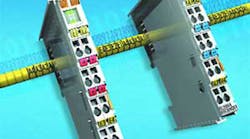Realtime control: Ethernet for control-automation technology (EtherCAT) eliminates network shortcomings
Early concerns about Ethernet as an automation network included its lack of real-time capabilities. But several new approaches seek to overcome this limitation. One company making waves in the industrial automation market is German-based Beckhoff (www.beckhoff.com). The release of its EtherCAT (Ethernet for control-automation technology) promises to move past the limitations of traditional fieldbus systems.
EtherCAT replaces standard star topology with a simple line structure. But the big bonus comes in the way the network processes data. Ethernet packets are no longer received then interpreted and copied as process data at every connection. The newly developed FMMU (fieldbus memory-management unit) in each I/O terminal reads data addressed to it while the message continues through the device.
On the hardware side, new Ethernet terminals are located in modular bus-terminal housings. In contrast to the bus terminals, there is no internal subbus. The Ethernet protocol remains intact right up to the individual terminal.
On the control side, the company's TwinCat network card driver complements the FMMU technology. An internal prioritization system and buffer located at the buffer end secures a free transmission channel for Ethernet frames from the queuing real-time system.
Other compatible protocols can operate in parallel on the same physical network. This not only includes standard IT protocols such as TCP/IP, HTTP, or FTP, but also industrial Ethernet protocols such as Modbus TCP, ProfiNet, or Ethernet IP.
The EtherCat protocol transmits directly within the Ethernet frame. Data sequence is independent of the physical order of the Ethernet terminals in the network. Addressing can be in any order and communication can be broadcast, multicast, or between slaves.
FMMU in the terminal and DMA access to the network card in the master lets complete protocol processing take place within hardware and is thus fully independent of the run time of protocol stacks, CPU performance, or software. The update time for 1,000 digital I/Os distributed over any number of stations is only 30 µsec, including terminal cycle time. And communication with 100 servoaxes takes only 100 µsec. During this time, each axis receives set values and control data and reports their actual position and status.
EtherCat also permits control concepts not possible on classic fieldbus systems. For instance, the Ethernet system can now not only deal with velocity control but also with the current control of distributed drives.
